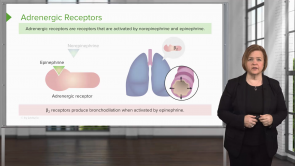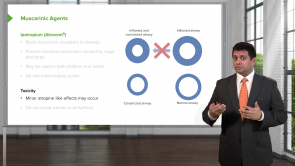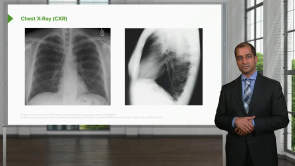Acute Hypercapnic

Über den Vortrag
Der Vortrag „Acute Hypercapnic“ von Carlo Raj, MD ist Bestandteil des Kurses „Respiratory Failures“.
Quiz zum Vortrag
Which of the following CNS lesions can cause hypercapnia?
- All answers are true
- Drugs decreasing respiratory drive
- Herniation of the brain
- Stroke
- Multiple sclerosis
Which of the following is NOT an example of a neuromyopathic disorder that causes acute hypercapnia?
- Malignant acanthosis nigricans
- Myasthenia gravis
- Muscular dystrophy
- Polymyositis
- Botulism
Which of the following is NOT a cause for chronic respiratory failure due to chronic hypoventilation?
- Hyaline membrane disease
- Obesity hypoventilation syndrome
- Kyphoscoliosis
- Amyotrophic lateral sclerosis
A patient is on treatment for chronic obstructive pulmonary disease for many years. His HCO3 levels are elevated in the urine. Which of the following better explains the underlying pathophysiology?
- Chronic hypoventilation causes the chemoreceptors to become unresponsive over many years, leading to the consumption of carbon dioxide for the formation of HCO3.
- Chronic hypoventilation causes the chemoreceptors to become stimulated over many years, leading to the consumption of carbon dioxide for the formation of HCO3.
- Chronic hypoventilation causes baroreceptors to become unresponsive over long periods leading to the consumption of carbon dioxide for the formation of HCO3.
- Chronic hypoventilation causes baroreceptors to become stimulated over long periods leading to the consumption of carbon dioxide for the formation of HCO3.
- Chronic hypoventilation causes no change in the carbon dioxide levels but the secretion of HCO3 occurs.
The pathophysiology of myasthenia gravis predisposes to death via which respiratory mechanism?
- Hypercapnic respiratory failure
- Hypoxemic respiratory failure
- Loss of hypoxic drive
- Respiratory center depression
- Inability of the muscle to relax
A patient has a normal tidal volume and an increased respiratory rate. What is the expected alveolar ventilation?
- Increased
- Decreased
- Remains the same
- Initially increased and then decreased
- Initially decreased and then increased
Which of the following can cause an increased dead space?
- Emphysema
- Asthma
- Sarcoidosis
- Interstitial lung disease
- Lung cancer
A 60-year-old patient has a decreased tidal volume and an increased respiratory rate. The total alveolar ventilation is decreased. The V/Q is 0. Which of the following is the most likely cause?
- Asthma
- Emphysema
- Hypoxia
- Lung cancer
- Tuberculosis
If the formula to find alveolar ventilation is (tidal volume - dead space) × frequency of respiration, which of the following values remains constant?
- Dead space
- Tidal volume
- Frequency of respiration
- Alveolar ventilation
- Tidal volume - dead space
Which of the following is the correct formula to assess the alveolar ventilation?
- Alveolar ventilation= ( tidal volume - dead space) × frequency of respiration
- Alveolar ventilation= (tidal volume + dead space) × frequency of respiration
- Alveolar ventilation= (dead space - tidal volume) × frequency of respiration
- Alveolar ventilation= (frequency of respiration- dead space) × tidal volume
- Alveolar ventilation=( tidal volume -frequency of respiration) × dead space
If a patient has alveolar ventilation of more than 7200 ml/min with a respiratory rate of 21/min along with a tidal volume of 600ml/min. What kind of breathing does one expect?
- Rapid deep breathing
- Rapid shallow breathing
- Slow shallow breathing
- Slow deep breathing
- Normal breathing
A patient has alveolar ventilation of 9000 ml/min, a respiratory rate of 20/min, and a tidal volume of 600ml/min. This is likely a respiratory compensation for which of the following?
- Metabolic acidosis
- Respiratory acidosis
- Metabolic alkalosis
- Initially, respiratory acidosis further converting to respiratory alkalosis
- Respiratory alkalosis
A patient has alveolar ventilation of 3000 mL/min with a respiratory rate of 20 and a tidal volume of 300 mL. What kind of breathing is expected to occur?
- Rapid shallow breathing
- Rapid deep breathing
- Slow shallow breathing
- Slow deep breathing
- Normal breathing
A patient has alveolar ventilation of 3000 ml/min with a respiratory rate of 20 and a tidal volume of 300ml/ min. What will happen to the patient's carbon dioxide level?
- Increase as there is less alveolar ventilation for exchange.
- Decrease as there is less alveolar ventilation for exchange.
- Remains unchanged
- Increase initially and eventually decreases
- Decreases initially and eventually increases
How is bicarbonate concentration affected in patients with chronic hypoventilation?
- Increases
- Decreases
- Remains the same
- Nullifies
- Changes proportional to the change in SaO2
Diese Kurse könnten Sie interessieren
Kundenrezensionen
5,0 von 5 Sternen
| 5 Sterne |
|
5 |
| 4 Sterne |
|
0 |
| 3 Sterne |
|
0 |
| 2 Sterne |
|
0 |
| 1 Stern |
|
0 |
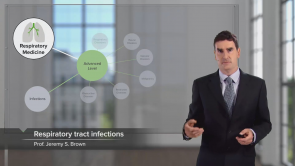

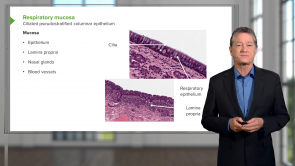
![Respiratory System [Archive]](https://assets-cdn1.lecturio.de/lecture_collection/image_medium/7488_1545146213.png)
